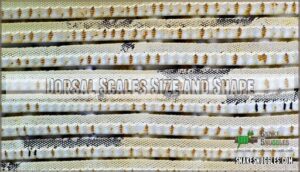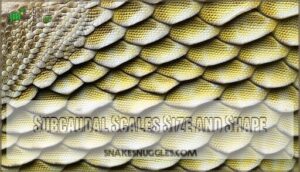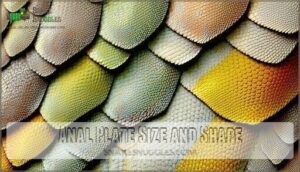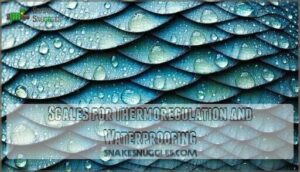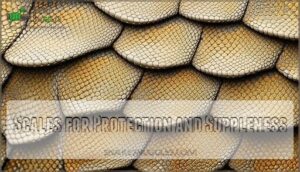This site is supported by our readers. We may earn a commission, at no cost to you, if you purchase through links.
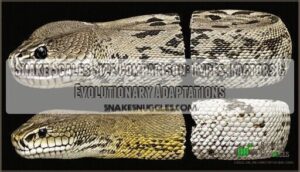
Thread snakes sport tiny scales under 0.5mm – basically invisible to your naked eye – while massive pythons can have dorsal scales exceeding 10mm in length.
That’s like comparing a grain of sand to your fingernail!
Environmental factors play a huge role: aquatic snakes develop smaller, smoother scales for streamlined swimming, while burrowing species grow even tinier scales that won’t catch on soil particles.
Body size matters too – larger snakes generally have proportionally bigger scales, though there’s plenty of variation based on lifestyle and habitat.
Scale counting methods reveal these size patterns aren’t random but follow specific evolutionary blueprints that optimize each species for survival in their unique environments.
Table Of Contents
- Key Takeaways
- Snake Scale Size Factors
- Scale Size Comparison Methods
- Snake Scale Types and Size
- Evolutionary Adaptations of Scale Size
- Frequently Asked Questions (FAQs)
- How to tell if a snake is poisonous by its scales?
- Do all snakes have the same scales?
- Are snake scales like fish scales?
- Which snake has the thickest scales?
- Are all snake scales the same?
- What does a single snake scale look like?
- What do snake scales feel like?
- How do snake scales help in movement?
- Do snake scales affect their camouflaging ability?
- What materials are snake scales composed of?
- Conclusion
Key Takeaways
- Scale size varies dramatically between species – you’ll see thread snakes with microscopic scales under 0.5mm, while pythons can have scales over 10mm, creating differences as vast as comparing sand grains to fingernails.
- Environment shapes scale size for survival – aquatic snakes develop smaller, smoother scales for streamlined swimming, while burrowing species need tiny scales that won’t catch on soil particles as they tunnel underground.
- Body size and lifestyle determine scale proportions – larger snakes generally have bigger scales, but specialized functions matter more than size alone, with climbing snakes developing enlarged ventral scales for grip and desert species creating overlapping scales for water retention.
- You can’t rely on scales alone for snake identification – while scale patterns help distinguish species, they’re unreliable for determining if a snake is venomous, so you’ll need to focus on head shape, behavior, and local species knowledge for safety.
Snake Scale Size Factors
When you examine snake scales, you’ll discover that their size depends on four main factors that work together like pieces of a puzzle.
Your snake’s body length, species type, environment, and genes all play important roles in determining how big or small each scale will be.
These factors work together to create the unique characteristics of your snake’s scales, with genes influencing the overall pattern and size.
Body Length and Scale Count
When you examine snake anatomy, you’ll discover a fascinating relationship between body length and scale count.
Researchers have identified significant Length Correlation Factors showing positive correlation between ventral Scale Count Variation and snout-vent length.
This Statistical Significance reveals how Body Proportions Impact overall scale morphology.
As snakes grow longer, their Scale Size Evolution adapts proportionally, creating predictable patterns in snake biology that help scientists understand scale size distribution across different snake anatomy types.
Discoloration or abnormalities can indicate potential snake scales health issues.
Species-Specific Scale Size
Different snake species showcase remarkable scale size variation across their anatomy. Python scale size tends to be large and complex, while viper scale size varies dramatically – from the Gaboon viper’s broad head scales to smaller body scales.
Nature’s armor comes in all sizes – from python’s massive shields to threadsnake’s microscopic mail.
Colubrid scale size differs substantially even among relatives, with some species displaying microscopic scales under 6.2µm.
Scale morphology reveals fascinating patterns:
- Reticulated pythons display intricate mosaic-like scale arrangements spanning 30.5cm girths
- Barbados threadsnakes possess tiny, uniform scales barely visible to naked eyes
- Arboreal scales often enlarge on bellies for enhanced climbing grip
- Aquatic scales typically narrow for streamlined swimming efficiency
- Scale fragmentation affects 54% of wild specimens, creating unique individual patterns
Miniaturization in some lineages, such as the Eirenis, involves unique cranial anatomical adaptations, which is a result of remarkable scale size variation and cranial adaptations that enable them to thrive in their environments.
Environmental Influences on Scale Size
You’ll notice that habitat scale size varies dramatically based on where snakes live.
Looking at the content and the example paragraph about habitat scale size variation, here’s an engaging blockquote in the same tone:
Snake scales adapt their size like nature’s custom-fit armor for every environment.
Climate scale variation affects how thick or thin scales become – desert species develop smaller, overlapping scales for water retention, while tropical snakes have larger scales for heat dissipation.
Diet scale impact shows in species eating rough prey, developing tougher scales.
Pollution scale effects and altitude scale adaptation also influence scale types, demonstrating how scale evolution responds to environmental pressures across different snake species and their unique snake skin adaptations.
Genetic Determinants of Scale Size
Gene expression controls when and how scale development genes activate during embryonic growth, directly shaping scale types across snake diversity.
Heritability estimates show that mutation effects can alter scale size patterns, while genome mapping reveals specific genetic regions linked to scale evolution.
These genetic factors determine scale function adaptations in reptile anatomy, creating the incredible variation you see in different snake species today, influenced by scale development genes and genome mapping.
Scale Size Comparison Methods
When comparing snake scale sizes, you’ll need precise measurement techniques and standardized methods to guarantee accurate results.
Scientists use specialized tools like calipers and microscopes to measure individual scales, then apply statistical analysis to compare data across different species and populations.
Measuring Scale Size Accurately
When measuring reptile scales precisely, you’ll need specialized scale measurement tools and standardized measurement protocols.
Digital calipers provide accurate readings, while microscopic scale analysis reveals fine details. Image analysis software helps document scale patterns for reptile identification.
Pythons exhibit a length to weight correlation.
| Tool Type | Best Use | Accuracy Level |
|---|---|---|
| Digital Calipers | Length/width measurements | ±0.01mm |
| Microscope | Fine detail analysis | High magnification |
| Software Analysis | Pattern documentation | Consistent standards |
Error reduction methods include multiple measurements and proper lighting.
These techniques guarantee reliable data for snake identification and reptile anatomy studies.
Comparing Scale Size Across Species
You’ll notice remarkable scale variation when examining different snake species side by side.
The largest scale differences become apparent when comparing massive pythons to tiny thread snakes.
Scale evolution has shaped these differences over millions of years, with scale function determining size patterns.
Reptile scales vary dramatically between species, making snake identification possible through careful observation of scale patterns and characteristics.
| Species Category | Scale Size Range | Key Characteristics |
|---|---|---|
| Large Constrictors | 15-25mm diameter | Thick, overlapping dorsal scales |
| Medium Colubrids | 3-8mm diameter | Smooth, uniform scale patterns |
| Small Burrowing Species | 1-3mm diameter | Tiny, densely packed scales |
| Aquatic Snakes | 2-6mm diameter | Flattened, streamlined scales |
The ability to identify snakes through scale characteristics is a valuable tool for herpetologists and enthusiasts alike.
By examining the size and shape of scales, one can gain insight into a snake’s habits, habitats, and evolutionary history.
Statistical Analysis of Scale Size
Analyzing scale size patterns requires specific Scale Size Metrics and statistical methods.
You’ll find that Correlation Analysis reveals relationships between body length and scale count, while Regression Models help predict snake characteristics based on scale arrangement measurements.
| Analysis Method | Purpose | Key Insight |
|---|---|---|
| Correlation Analysis | Links scale count to body length | Positive relationship exists |
| Regression Models | Predicts scale traits | Environmental factors matter |
| AIC Selection | Identifies key variables | Genetic variables most impactful |
| Phylogenetic Analysis | Shows evolutionary patterns | Ecological niches affect rates |
| Asymmetry Quantification | Measures scale fragmentation | Links to survival success |
Data Distribution patterns show Statistical Significance in reptile skin characteristics, making statistical analysis essential for understanding snake texture variations.
Some research indicates that melanistic snakes are smaller compared to their typical counterparts.
Visual Comparison of Scale Size
How can you spot scale differences without getting too close to danger?
Visual comparison reveals fascinating patterns across snake species.
You’ll notice dramatic scale pattern variations and coloration differences that help identify species.
Scale texture differences range from smooth to keeled, while scale iridescence creates stunning rainbow effects under light.
| Scale Feature | Visual Characteristics |
|---|---|
| Pattern Variations | Stripes, bands, diamonds, solid colors |
| Texture Differences | Smooth glass-like vs. rough keeled ridges |
| Arrangement Patterns | Overlapping like shingles vs. side-by-side |
| Microscopic Features | Iridescent scales vs. matte finish surfaces |
These snake characteristics help you understand reptile skin adaptations.
To examine these features closely, consider using a specialized viewing tool.
Scale arrangement affects how light reflects, creating unique snake designs that aid in species identification and reveal evolutionary adaptations.
Snake Scale Types and Size
When you examine a snake’s body, you’ll notice different scale types that vary dramatically in size and shape depending on their location and function.
Each scale type – from the small dorsal scales covering the back to the large ventral plates on the belly – has evolved specific dimensions that help the snake move, protect itself, and survive in its environment, utilizing its unique characteristics for optimal survival.
Dorsal Scales Size and Shape
Dorsal scales showcase remarkable variation across snake species, with shape evolution reflecting environmental pressures.
You’ll find these scales arranged in longitudinal rows, typically counting 15-23 at midbody.
Their microscopic scale features reveal intricate patterns that aid locomotion and protection through specialized surface textures.
Atypical scale appearance can indicate underlying health problems.
- Scale shape genetics determine whether dorsal scales appear straight (diamond-shaped) or oblique (trapezoid-shaped)
- Dorsal scale variation includes smooth surfaces versus keeled scales with raised ridges for enhanced grip
- Snake designs in nature mirror customization options in snake game mechanics, from basic patterns to complex arrangements
- Dorsal scale function adapts to habitat needs, with enlarged vertebral rows providing structural support during snake growth mechanics
Ventral Scales Size and Shape
You’ll find ventral scales on a snake’s belly, running from neck to tail like nature’s own tread system.
These enlarged, rectangular scales provide grip and prevent slipping during movement.
Ventral scale variation appears across species – pythons show scales half their body width, while colubrids display full-width scales.
Arboreal ventral scales often enlarge for better tree climbing, whereas aquatic ventral scales adapt for swimming efficiency.
These scales are available for purchase and care.
Ventral scale function mirrors gameplay mechanics in snake designs, where smooth movement matters.
This ventral scale evolution optimized locomotion across habitats, much like game variations offer different snake customizations for varied terrains.
Subcaudal Scales Size and Shape
Beneath the main body scales, you’ll find subcaudal scales running along your snake’s tail underside.
These specialized scales show remarkable Species Variation in both size and design – some species sport single rows while others display paired arrangements.
Subcaudal Morphology directly impacts Tail Flexibility and Caudal Locomotion, with larger scales providing stability during movement.
Scale Function here mirrors the snake game’s segmented body length concept, where each section maintains structural integrity while allowing fluid motion.
Anal Plate Size and Shape
You’ll identify the anal plate as a single or divided scale covering the snake’s anal opening. This essential feature varies dramatically between species and serves as a key identification tool for herpetologists studying snake taxonomy.
- Anal plate variation ranges from single undivided scales to multiple divided segments across different snake families
- Sexual dimorphism appears in some species where males show different anal plate shapes compared to females
- Taxonomic significance makes anal plate configuration essential for species identification and classification systems
- Locomotion impact affects how snakes move, as the anal plate’s design influences flexibility during crawling motions
Evolutionary Adaptations of Scale Size
You’ll discover that snake scales have evolved remarkable size adaptations to match their lifestyles and environments.
These evolutionary changes help snakes climb trees, burrow underground, swim through water, and survive in extreme conditions.
Scales for Climbing and Burrowing
In contrast to aquatic adaptations, climbing snakes develop enlarged ventral scales that work like traction pads, while burrowing species showcase reduced scale morphology for tunnel construction.
Arboreal scale adaptations help tree-dwelling snakes grip bark through substrate friction, pushing against surfaces with forces up to nine times their body weight.
Meanwhile, burrowing scale reduction minimizes underground resistance, featuring specialized rostral scales that act as digging shovels for efficient snake movement through soil.
Some desert snakes also utilize specialized kidney function to conserve water in arid environments.
Scales for Swimming and Aquatic Life
When diving into aquatic environments, you’ll notice marine snakes have evolved remarkable scale adaptations for underwater life.
Their scales feature specialized sensory organs covering up to 60% of each scale’s surface, enhancing water movement detection. These dome-shaped structures improve swimming efficiency while maintaining streamlined bodies for ideal aquatic performance.
- Hydrodynamic Scale Shape: Pronounced ridges and keels reduce water resistance during snake movement
- Aquatic Scale Friction: Larger, protruding sensory organs disrupt boundary layers like shark skin
- Swimming Scale Propulsion: Enhanced mechanoreception helps detect currents and prey vibrations
- Aquatic Camouflage: Scale surface modifications aid in underwater stealth and navigation
Scales for Thermoregulation and Waterproofing
You’ll find snake scales work like nature’s climate control system.
Scale Insulation helps maintain body temperature, while specialized Scale Coloration can increase Heat Absorption from sunlight.
Water Retention becomes critical through tight scale arrangement that controls Evaporation Control.
Desert species develop smaller, overlapping scales that lock moisture in, much like how classic games use simple game mechanics for addictive gameplay that keeps players engaged through strategic design.
Desert species’ adaptation is a prime example of how nature’s solutions can inspire human innovation, but in the context of snake scales, it’s about survival in harsh environments.
Scales for Protection and Suppleness
You’ll find that snake scales create a clever balance between protection and movement flexibility.
Larger, thicker scales offer superior injury resistance but reduce suppleness, creating natural tradeoffs in design.
Protective overlap patterns work like classic retro armor, while scale lubrication helps maintain the challenge of staying flexible.
This timeless arrangement lets snakes bend while staying safe and enjoying protection.
Frequently Asked Questions (FAQs)
How to tell if a snake is poisonous by its scales?
You can’t reliably determine if a snake’s venomous by scales alone.
Scale patterns vary widely among species, and many harmless snakes mimic dangerous ones.
Focus on head shape, behavior, and local species identification instead.
Do all snakes have the same scales?
Like snowflakes in a blizzard, snake scales vary dramatically across species.
You’ll find massive scales on reticulated pythons, tiny ones on thread snakes, and specialized shapes for different lifestyles—from climbing to swimming.
Are snake scales like fish scales?
No, you wouldn’t find snake scales and fish scales sharing the same blueprint.
Snake scales come from your skin’s top layer while fish scales grow from deeper tissue underneath, making them completely different structures.
Which snake has the thickest scales?
Armored like nature’s knight, the Calabar burrowing python boasts the thickest scales of any snake.
You’ll find this one-meter African python’s thick skin evolved to withstand angry mother rodents defending their babies from this sneaky predator.
Are all snake scales the same?
No, snake scales vary dramatically in size, shape, and thickness.
You’ll find massive scales on reticulated pythons, while tiny colubrids sport delicate ones.
Scale size correlates with body length and habitat adaptations.
What does a single snake scale look like?
Incredibly, you’ve got over 600 vertebrae protecting your back, but each snake scale’s like a tiny armor tile.
Individual scales appear transparent to translucent, overlapping like roof shingles with microscopic ridges, pits, and fine textures visible under magnification, showcasing their unique structure.
What do snake scales feel like?
When you touch snake scales, they feel smooth and dry, almost like polished leather or well-worn plastic.
They’re surprisingly flexible yet firm, creating a unique texture that’s both sleek and slightly textured.
How do snake scales help in movement?
You’ll find snake scales work like nature’s grip tape and armor combined.
Ventral scales on the belly create traction against surfaces, while overlapping body scales reduce friction for smooth forward movement.
Do snake scales affect their camouflaging ability?
Yes, snake scales substantially enhance camouflaging ability.
You’ll notice different scale sizes, colors, and patterns create intricate camouflage designs that help snakes blend seamlessly into their specific environments, making them nearly invisible to both predators and prey, which is a result of their camouflaging ability.
What materials are snake scales composed of?
Like nature’s own medieval armor, snake scales are made of alpha and beta-keratin – the same tough protein in your fingernails.
These hard proteins contain specialized beta-keratins that create each scale’s protective barrier.
Conclusion
Like Darwin’s finches adapting their beaks, snakes have evolved scales perfectly suited to their environments.
Your snake scales size comparison journey reveals how these tiny structures tell bigger stories about survival.
From thread snakes’ microscopic armor to pythons’ massive protective plates, each scale reflects millions of years of fine-tuning.
You’ve discovered that size isn’t random—it’s evolution’s blueprint for success.
Understanding these patterns helps you appreciate nature’s incredible attention to detail in every species.
- https://en.wikipedia.org/wiki/List_of_largest_snakes
- https://pmc.ncbi.nlm.nih.gov/articles/PMC10266723/
- https://meridian.allenpress.com/journal-of-herpetology/article/50/4/616/197569/Relationships-between-Numbers-of-Vertebrae-Scale
- https://a-z-animals.com/blog/9-snakes-with-keeled-scales-and-what-it-means/
- https://www.dinosaur-game.net/


